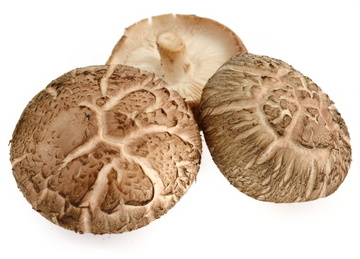Health Benefits of Shiitake Mushroom
By Irina Bright.
 Shiitake mushroom.
Shiitake mushroom.
Shiitake mushrooms (Lentinula edodes), like many other medicinal mushroom species, originate in Eastern Asia where they had been used for thousands of years for their taste and health-boosting properties.
Widely consumed as a culinary ingredient, shiitake have an amazing nutritional profile which has been recognized by nutritional experts and conventional medical professionals alike.
Low in calories and high in vitamins, minerals, amino acids, carbohydrates, fibre and other vital nutrients, shiitake present an excellent choice for quickly rejuvenating the body and revitalizing the mind. (Ref. 1)
Full of highly beneficial chemical compounds, such as polysaccharides (ex., lentinan and beta-glucans), alkaloids (eritadenine) and other valuable compounds, shiitake offer deep healing for those of us seeking to naturally improve our health and quality of life. (Ref. 2 and 3)
Shiitake have become most famous for providing a strong support to the immune system, thanks to the work of its polysaccharides.
Beta-glucans found in shiitake and other mushrooms are specifically used to treat tiredness and chronic fatigue syndrome. (Ref. 4)
Just like their other famous "relative" - reishi mushroom, shiitake are capable of modulating the immune system - i.e, bringing it back into balance. When the immune system is over-active, shiitake will have a calming effect on it; when the system is under-performing - they will encourage it to be more active. (Ref. 5)
These mushrooms also have a positive impact on the immune cells called macrophages which are responsible for clearing the debris out of the body, especially dead and cancerous cells. (Ref. 6)
As an "extension" of its immunomodulating properties, shiitake may possibly be considered an adaptogen as well. This means that they may protect the body from potential damage due to stress and help to restore its functions naturally.
Apart from that, shiitake deliver many other benefits, including support for the cardiovascular system and protection from oxidative stress, thanks to its anti-oxidant capacity. (Ref. 7)
Shiitake also work as anti-fungal, anti-bacterial and anti-viral agents and are a highly popular remedy for dealing with colds and flus. (Ref. 8, 9 and 10)
By working on our bodies as a whole, shiitake *lift us up* in a completely natural way and leave us feeling energised for longer.
Written by: Irina Bright
Original publication date: 2013
Updates: 2020
Republication date: 2020
References.
1. USDA Nutrient Data Laboratory (2013). Nutrient data for 11238, Mushrooms, shiitake, raw. Release 25. Retrieved June 6, 2013 from: https://ndb.nal.usda.gov/ndb/foods/show/2973?fg=&man=&lfacet=&count=&max=25&sort=&qlookup=shiitake+&offset=&format=Full&new=
2. Jane E Ramberg, Erika D Nelson, and Robert A Sinnott (2010). Immunomodulatory dietary polysaccharides: a systematic review of the literature. Published in Nutrition Journal. Retrieved June 6, 2013 from: https://www.ncbi.nlm.nih.gov/pmc/articles/PMC2998446/
3. Enman J, Hodge D, Berglund KA, Rova U (2008). Production of the bioactive compound eritadenine by submerged cultivation of shiitake (Lentinus edodes) mycelia. Published in Journal of agricultural and food chemistry. Retrieved June 6, 2013 from: https://www.ncbi.nlm.nih.gov/pubmed/18363329
4. Sandeep Rahar, Gaurav Swami, Navneet Nagpal, Manisha A. Nagpal, and Gagan Shah Singh (2011). Preparation, characterization, and biological properties of -glucans. Published in Journal of Advanced Phramaceutical Technology & Research. Retrieved June 6, 2013 from: https://www.ncbi.nlm.nih.gov/pmc/articles/PMC3217690/
5. Masashi Mizuno, and Yosuke Nishitani (2013). Immunomodulating compounds in Basidiomycetes. Published in Journal of Clinical Biochemistry and Nutrition. Retrieved June 6, 2013 from: https://www.ncbi.nlm.nih.gov/pmc/articles/PMC3652302/
6. Kenji Ina, Takae Kataoka, and Takafumi Ando (2013). The Use of Lentinan for Treating Gastric Cancer. Published in Anti-Cancer Agents in Medicinal Chemistry. Retrieved June 6, 2013 from: https://www.ncbi.nlm.nih.gov/pmc/articles/PMC3664515/
7. Keith R Martin (2010). Both common and specialty mushrooms inhibit adhesion molecule expression and in vitro binding of monocytes to human aortic endothelial cells in a pro-inflammatory environment. Published in Nutrition Journal. Retrieved June 6, 2013 from: https://www.ncbi.nlm.nih.gov/pmc/articles/PMC2916885/
8. Hearst R, Nelson D, McCollum G, Millar BC, Maeda Y, Goldsmith CE, Rooney PJ, Loughrey A, Rao JR, Moore JE (2009). An examination of antibacterial and antifungal properties of constituents of Shiitake (Lentinula edodes) and oyster (Pleurotus ostreatus) mushrooms. Published in Complementary therapies in clinical practice. Retrieved June 6, 2013 from: https://www.ncbi.nlm.nih.gov/pubmed/19161947
9. Vinicius Pires Rinco, Kristie Aimi Yamamoto, Ngila Maria Pontes Silva Ricardo, Sandra Aguiar Soares, Luzia Doretto Paccola Meirelles, Carlos Nozawa, and Rosa Elisa Carvalho Linhares (2012). Polysaccharide and extracts from Lentinula edodes: structural features and antiviral activity. Published in Virology Journal. Retrieved June 6, 2013 from: https://www.ncbi.nlm.nih.gov/pmc/articles/PMC3292946/
10. Bisen PS, Baghel RK, Sanodiya BS, Thakur GS, Prasad GB (2010). Lentinus edodes: a macrofungus with pharmacological activities. Published in Current medicinal chemistry. Retrieved June 6, 2013 from: https://www.ncbi.nlm.nih.gov/pubmed/20491636